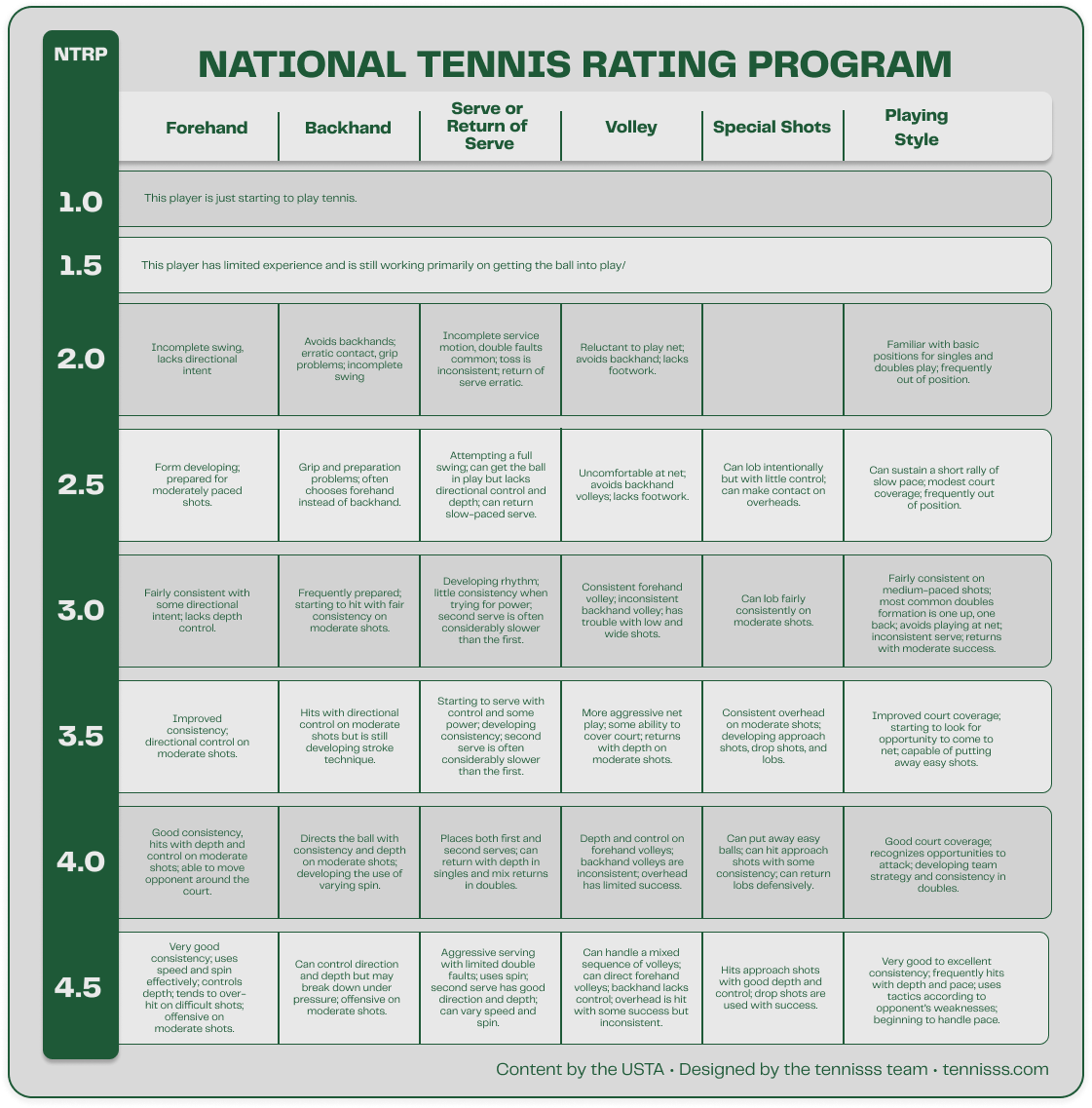THE ULTIMATE GUIDE TO NTRP RATINGS

This guide breaks down how to self-assess your NTRP level, how it compares to WTN and UTR ratings, and why accurate evaluation matters more than ever, especially if you are looking to improve.
What Is NTRP?
The National Tennis Rating Program (NTRP) is a skill-level scale ranging from 1.0 (beginner) to 7.0 (professional-level) used by the USTA and most adult tennis leagues in North America. It’s how recreational players are grouped for fair matches and progression.
The Scale (Simplified):
- 1.0–2.5: Beginner
- 3.0–3.5: Developing consistency
- 4.0–4.5: Advanced club/recreational
- 5.0+: Tournament-level and beyond
How to Find Your NTRP Rating
There are two main ways to determine your rating:
✅ Self-Rating
Use the below USTA self-rating guide to compare yourself across key skills: stroke mechanics, consistency, and match play.
💻 USTA Ratings
If you’ve played in USTA leagues or tournaments, your results are fed into the USTA’s algorithm to calculate a verified rating. USTA no longer uses human assessors; it is fully data-driven now.
⚠️ Tennisss Assessment
Get assessed by one of our certified coaches for a more precise ranking with actionable next steps to improve your game.

Why Self-Rating Is Hard (and Often Wrong)
Most players overrate or underrate themselves, because NTRP is not just about effort, it is about outcomes and technique.
- You can hustle to win matches at 3.0 without 3.0 technique.
- A technically strong 2.5 player might lose to a scrappy 3.0, but they’ll eventually surpass them.
That is why we propose not just one rating, but three.
A Better Way to Think About NTRP: 3 Ratings, Not One
To help players (and coaches) better understand their game, we suggest breaking it down into three distinct types of NTRP:
1. 🏆 Playing / League NTRP
What level can you currently play at?
2. 🛠️ Technical / Training NTRP
How far along are you in developing the strokes, consistency, and movement needed to reach the Advanced (4.0 - 4.5) level or higher?
3. 🌍 Tournament NTRP
For example, some “4.0” events may play more like 3.5. This perspective helps coaches guide players who are ready to train at a higher level, even if they are not yet winning there.
--
The NTRP system identifies general levels of ability, but an individual will be rated within those levels at 50 different hundredths of a point. For example, a 3.5 player can fall anywhere between a 3.01 and a 3.50. A typical match result for a player with a 3.01 rating versus a 3.49 player, both of whom are 3.5s, would be 6-0, 6-0 in favor of the higher rated player.
With our assessment:
- You get a precise NTRP rating (e.g., 3.3)
- Plus feedback on Playing vs. Training NTRP
- So you can find better hitting partners, enter the right level, and improve faster
FAQs About Tennis Ratings in Canada
- Is NTRP used in Canada? Mostly as a self-rating tool. Tennis Canada uses WTN officially.
- Can I convert my rating? Not officially, but conversion charts like the one from Tennis BC are widely used.
- Is your assessment USTA-approved? No, but neither are local coaches or clubs. We offer the most complete, structured alternative available online.
- Why get an online assessment? If you're not playing USTA events, there’s no official way to get a rating. Our assessments help you understand where you stand and what to work on.
🎯 Ready to level up with clarity?
Whether you're a 2.5 aiming to build 4.0 technique or a 4.0 wondering why you can’t crack into higher-level tournaments, knowing your exact NTRP rating, not just a ballpark guess, is the first step.
Get a detailed video assessment with personalized feedback, side-by-side breakdowns, and a custom score like 3.2 or 4.1 that reflects both how you play now and where you're headed.
👉 Join the waitlist to be first in line to get your assessment and know your true level.
Other Questions:
Can You Convert NTRP to WTN?
Officially, no. These systems are built on different algorithms and data sets. However, players and organizations frequently look for equivalencies to help with tournament registration or finding compatible hitting partners so you can use this as a rough guide.
(NTRP)
(NTRP)
(WTN)
How NTRP Compares to WTN and UTR
If you’ve also heard of WTN or UTR, here’s how they stack up:
WTN is gaining traction in Canada, where Tennis Canada now uses it to determine eligibility for tournaments. UTR is often used for competitive juniors and college recruiting, but less so in recreational contexts.
